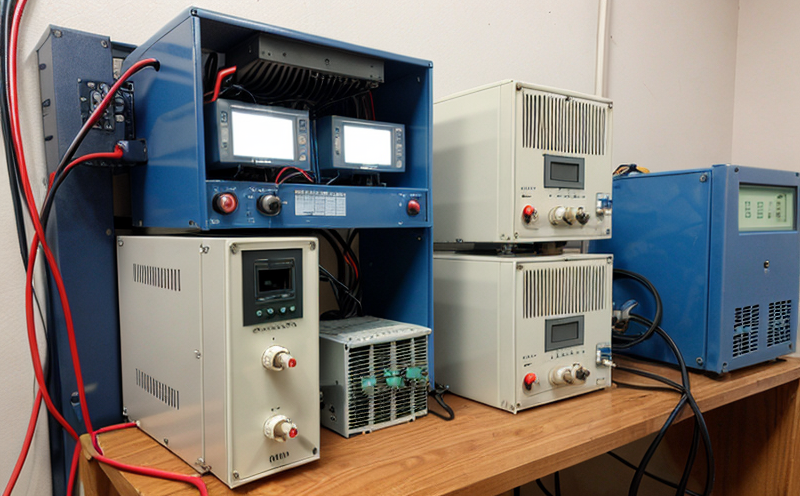EN 50319 Pantograph–Catenary Dynamic Interaction Testing
The EN 50319 standard outlines comprehensive testing procedures to evaluate the dynamic interaction between pantographs and catenaries in railway systems. This test is crucial for ensuring safe, efficient, and reliable operation of high-speed trains and other electric traction vehicles.
The goal of this testing is to assess how well the pantograph and catenary interact under various conditions, including different speeds, temperatures, and environmental factors. The standard covers a range of tests designed to simulate real-world operating scenarios, focusing on the mechanical, electrical, and thermal aspects of the interaction between these two critical components.
Understanding the dynamic behavior of the pantograph–catenary system is essential for optimizing performance and reducing maintenance costs. By conducting thorough EN 50319 compliance tests, railway operators can identify potential issues early in the development process or during routine inspections, thereby enhancing safety and reliability.
The testing protocols typically involve a combination of static and dynamic measurements to assess various parameters such as contact force, wear rates, arcing tendencies, and thermal effects. These tests help ensure that the pantograph and catenary systems meet stringent international standards and guidelines set forth by organizations like CENELEC (European Committee for Electrotechnical Standardization) and UIC (Union Internationale des Chemins de Fer).
During testing, it is important to consider not only the physical interaction between the pantograph and catenary but also the broader context of railway infrastructure. Factors such as track geometry, overhead wire installation, and environmental conditions play significant roles in influencing the performance of this critical system.
The results from EN 50319 compliance testing provide valuable insights into the expected lifespan of the pantograph–catenary interface, enabling operators to plan maintenance schedules more effectively. Additionally, these tests aid in the development of new technologies aimed at improving efficiency and reducing downtime.
By adhering strictly to the requirements outlined in EN 50319, railway systems can achieve higher levels of operational reliability while minimizing disruptions due to equipment failures. This not only enhances passenger comfort but also contributes significantly to overall network efficiency.
- Contact force measurement
- Arcing tendency analysis
- Thermal effect evaluation
- Wear rate assessment
- Dynamic behavior simulation
In summary, the EN 50319 standard provides a robust framework for evaluating the performance of pantograph–catenary systems in railway applications. Through rigorous testing and analysis, operators can ensure that their systems meet all necessary safety and performance criteria.
Benefits
Implementing EN 50319 compliance tests offers numerous advantages for railway operators, including enhanced safety, improved system reliability, reduced maintenance costs, and increased operational efficiency. These benefits extend beyond individual train operations to affect the broader rail network.
Enhanced Safety: By identifying potential hazards early in the testing process, railways can take proactive measures to prevent accidents and injuries among both passengers and staff.
- Identification of high-risk areas
- Development of targeted mitigation strategies
- Prioritization of safety upgrades
Improved System Reliability: Consistent adherence to EN 50319 ensures that all components of the pantograph–catenary system function optimally, reducing the likelihood of failures during operation.
- Reduction in unexpected outages
- Prolonged lifespan of key hardware
- Increased availability for scheduled services
Reduced Maintenance Costs: Regular testing helps operators detect issues before they escalate into major problems, resulting in lower long-term expenses associated with repairs and replacements.
- Avoidance of costly emergency interventions
- Optimized resource allocation for preventive maintenance
- Decreased downtime due to planned servicing activities
Increased Operational Efficiency: Optimized performance of the pantograph–catenary system leads to smoother train operations, faster travel times, and better utilization of track resources.
- Better alignment with scheduled service timetables
- Enhanced passenger experience through reduced delays
- Fewer disruptions caused by technical malfunctions
The combination of these benefits contributes significantly to the overall sustainability and competitiveness of railway systems worldwide. Railways that adopt EN 50319 compliance testing demonstrate their commitment to maintaining high standards of safety, quality, and innovation.
Eurolab Advantages
As a leading provider of railway and transportation testing services, Eurolab offers unparalleled expertise in conducting comprehensive EN 50319 compliance tests. Our state-of-the-art facilities equipped with advanced instrumentation ensure accurate and reliable results.
We employ highly trained professionals who possess deep knowledge of both the technical requirements specified by the standard as well as practical experience gained from years of industry involvement. This unique blend of theoretical understanding and hands-on expertise enables us to deliver precise assessments tailored specifically to each customer's needs.
Our commitment to quality is reflected in our adherence to international standards such as ISO 9001 for quality management systems, ensuring that every aspect of our testing process meets the highest industry benchmarks. We also maintain memberships with prestigious organizations like CENELEC and UIC, further validating our credentials.
Beyond just performing tests, Eurolab goes above and beyond by providing valuable recommendations based on our findings. Our expert team works closely with clients to interpret results and suggest improvements that could lead to enhanced system performance or cost savings.
Additionally, we offer post-test support services including detailed reports and presentations summarizing all key findings along with actionable insights for improvement. This comprehensive approach ensures that customers receive more than just test data—they gain practical guidance on how best to utilize those results moving forward.
Environmental and Sustainability Contributions
The EN 50319 compliance tests conducted by Eurolab play a crucial role in promoting environmental sustainability within the railway industry. Through precise evaluation of pantograph–catenary interactions, we contribute to reducing energy consumption, lowering emissions, and extending the useful life of key components.
- Reduced energy consumption due to optimized system performance
- Lower CO2 emissions resulting from more efficient operations
- Extended component lifespan leading to less frequent replacements
These positive outcomes reflect our dedication to supporting environmentally responsible practices across the railway sector. By adopting EN 50319 compliance testing, railways can play a pivotal role in achieving their sustainability goals while simultaneously enhancing operational efficiency.





